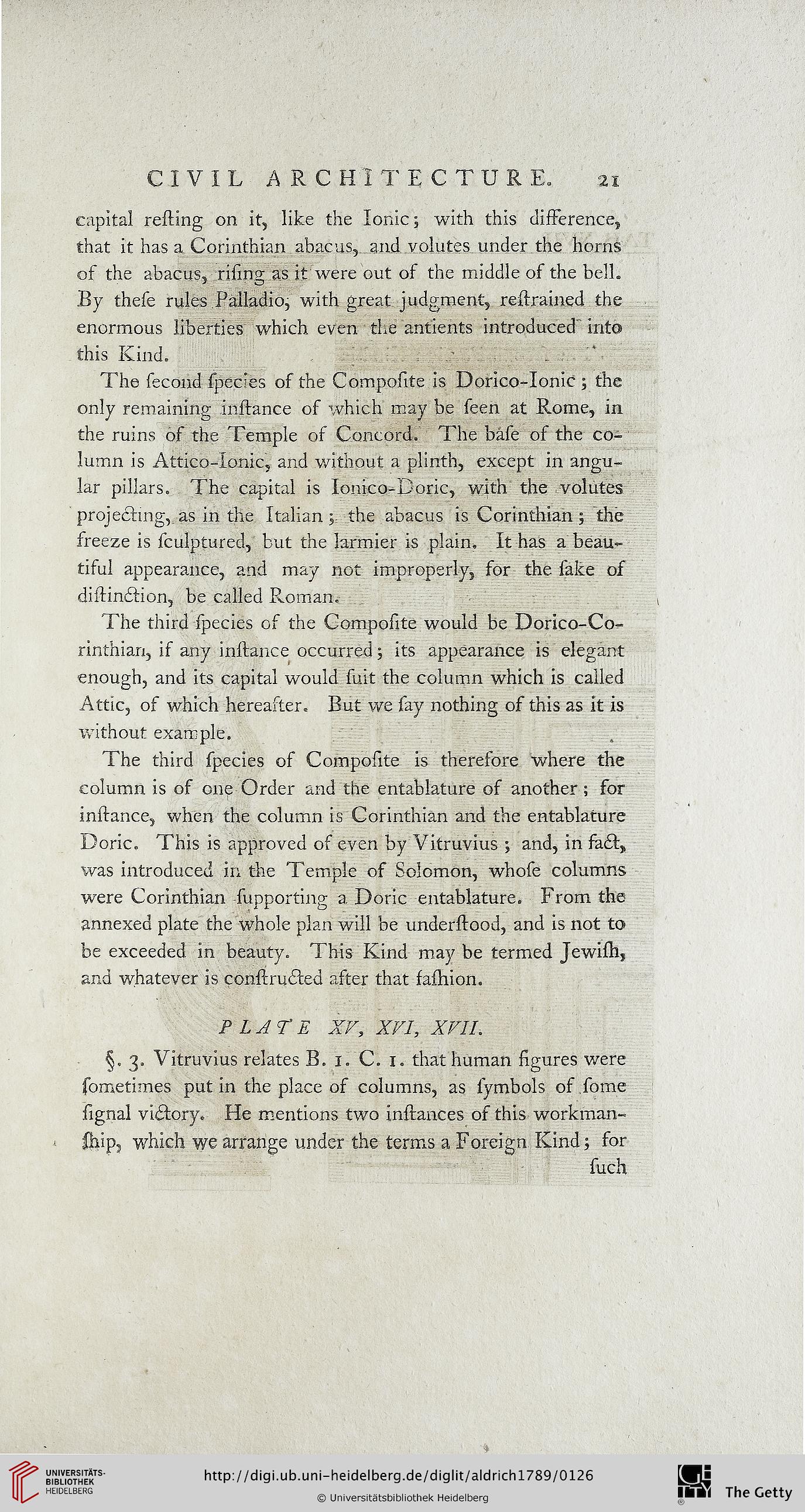CIVIL ARCHITECTURE. 21
capital resting on it, like the Ionic; with this difference,
that it has a Corinthian abacus, and volutes under the horns
of the abacus, riling as it were out of the middle of the bell.
By these rules Palladio, with great judgment, restrained the
enormous liberties which even the antients introduced into
this Kind.
The second spec'es of the Composite is Dorico-Ionic ; the
only remaining instance of which may be seen at Rome, in
the ruins of the Temple of Concord. The base of the co-
lumn is Attico-Ionic, and without a plinth, except in angu-
lar pillars. The capital is Ionico-Doric, with the volutes
projecting,, as in the Italian the abacus is Corinthian ; the
freeze is sculptured, but the larmier is plain. It has a beau-
tiful appearance, and may not improperly, for the sake of
distindtion, be called Roman.
The third species of the Composite would be Dorico-Co-
rinthian, is any instance occurred; its appearance is elegant
enough, and its capital would suit the column which is called
Attic, of which hereaster. But we say nothing of this as it is
without example.
The third species of Composite is therefore where the
column is of one Order and the entablature of another; for
instance, when the column is Corinthian and the entablature
Doric. This is approved of even by Vitruvius ; and, in fadt,
was introduced in the Temple of Solomon, whose columns
were Corinthian supporting a Doric entablature. From the
annexed plate the whole plan will be understood, and is not to
be exceeded in beauty. This Kind may be termed Jewilh,
and whatever is construdted after that fashion.
PLATE XV, XVI, XVII.
§. 3. Vitruvius relates B. 1. C. 1. that human figures were
sometimes putin the place os columns, as symbols of some
signal vidtory. He mentions two instances of this workman-
ship, which we arrange under the terms a Foreign Kind; for
such
capital resting on it, like the Ionic; with this difference,
that it has a Corinthian abacus, and volutes under the horns
of the abacus, riling as it were out of the middle of the bell.
By these rules Palladio, with great judgment, restrained the
enormous liberties which even the antients introduced into
this Kind.
The second spec'es of the Composite is Dorico-Ionic ; the
only remaining instance of which may be seen at Rome, in
the ruins of the Temple of Concord. The base of the co-
lumn is Attico-Ionic, and without a plinth, except in angu-
lar pillars. The capital is Ionico-Doric, with the volutes
projecting,, as in the Italian the abacus is Corinthian ; the
freeze is sculptured, but the larmier is plain. It has a beau-
tiful appearance, and may not improperly, for the sake of
distindtion, be called Roman.
The third species of the Composite would be Dorico-Co-
rinthian, is any instance occurred; its appearance is elegant
enough, and its capital would suit the column which is called
Attic, of which hereaster. But we say nothing of this as it is
without example.
The third species of Composite is therefore where the
column is of one Order and the entablature of another; for
instance, when the column is Corinthian and the entablature
Doric. This is approved of even by Vitruvius ; and, in fadt,
was introduced in the Temple of Solomon, whose columns
were Corinthian supporting a Doric entablature. From the
annexed plate the whole plan will be understood, and is not to
be exceeded in beauty. This Kind may be termed Jewilh,
and whatever is construdted after that fashion.
PLATE XV, XVI, XVII.
§. 3. Vitruvius relates B. 1. C. 1. that human figures were
sometimes putin the place os columns, as symbols of some
signal vidtory. He mentions two instances of this workman-
ship, which we arrange under the terms a Foreign Kind; for
such





